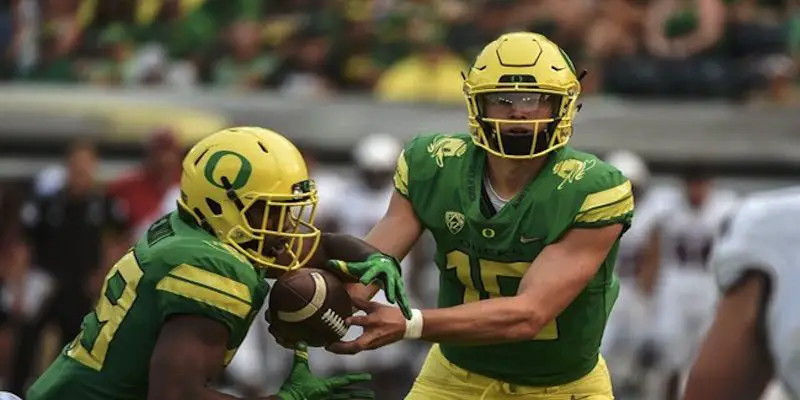Something became somewhat obvious in Oregon’s first two games. Then it became crystal clear against Wyoming: Coach Taggart is going to utilize Justin Herbert’s running ability, no matter how some think the quarterback should and should not be used.
Honestly, it’s a smart move.
When I say that Taggart is going to use Herbert in the run game, I don’t mean this is going to be like Denard Robinson at the University of Michigan. I get this feeling that if the quarterback is a part of the run game, fans get this idea that he’s going to be running all the time and getting beaten up. Runs for Herbert are only being thrown in here and there to catch defenses out of position and to take advantage of the focus directed towards Royce Freeman.
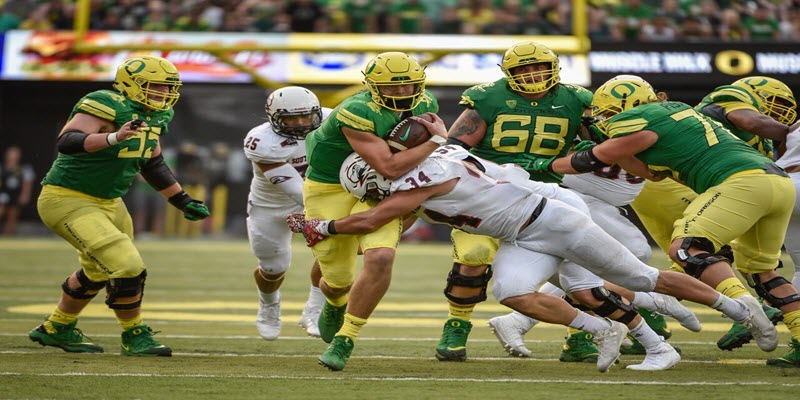
The use of Herbert’s legs will aide Oregon’s run game.
Toss Read
Here, we’re going to touch on a few ways that Taggart has used Herbert’s feet in the first three games. The first play is the toss read, diagramed below. I wrote an article breaking down the toss read back in the offseason while we were taking a look at Taggart’s power spread.
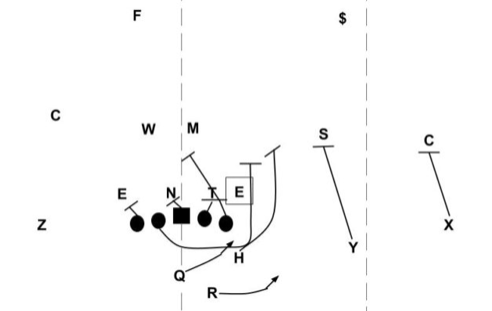
Diagram of the toss read
Blocking for this play is the same as the inverted veer/power read. The offensive line is going to down block, except for the backside guard who is going to pull through the C gap, the space to the outside shoulder of the offensive tackle.
The difference between the toss read and the inverted veer is a toss instead of a cross-face handoff. If the QB reads give, he’s going to toss the ball to the running back. If he reads keep, he’s going to run the ball behind the pulling guard.
As you can see in the example above, Herbert runs the toss read and picks up eight yards, nearing a first down. He read the play perfectly and took advantage of the defense’s over pursuit towards Kani Benoit.
QB Power
The next play on our list is the QB draw/power. The QB power is another play that I broke down this offseason while addressing some of the staple plays of Taggart’s system. This is a play that Coach Taggart likes to attach a WR screen to. It allows the QB to read the outside linebacker so that he can decide whether he should throw the screen or keep the ball and run the power.
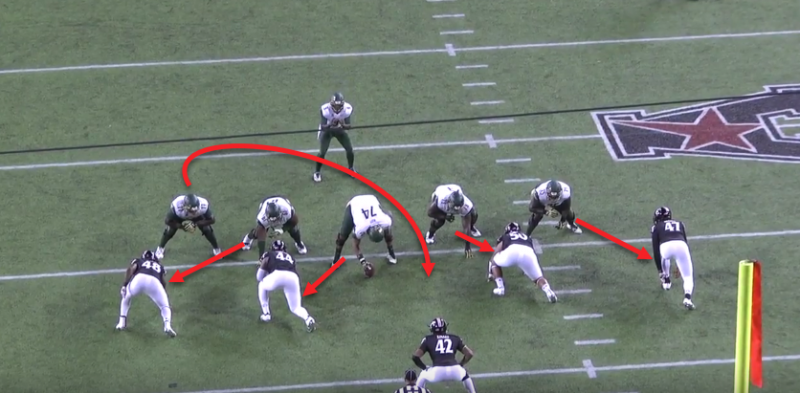
The QB power
As shown above, blocking of the offensive line is a variation of the traditional power run. Here, the backside of the line is going to down block and the front side is going to zone block while the backside tackle pulls through the A gap (the space on either side of the center) to lead for the QB.
Unless he had decided pre-snap that the OLB was already out of position, the version that Herbert ran (above) was more akin to a draw play, although the blocking is exactly the same. I would have liked to have seen a glance toward the screen, but that’s just a nitpick. All goes well here, and Herbert picks up four yards and the first down.
Zone Read
The final play we’re going to visit is the zone read. It is a fantastic idea to have complement plays to your run plays, and the zone read is a great complement to the inside zone. It is going to be a huge benefit to Oregon when defenses are overreacting to Freeman on the inside zone. As the saying goes: It’s an oldie, but a goodie.
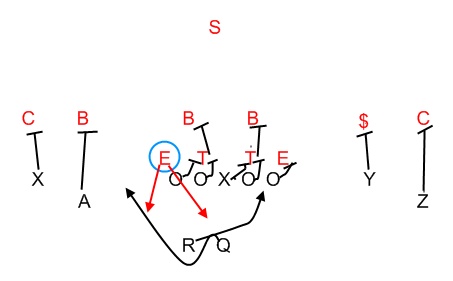
The zone read
The diagram above is an illustration of the zone read. It is a very simple yet effective play. The blocking is the same as the inside zone, except the back side defensive end is left unblocked. This DE is the defensive player that the QB is going to read. If the DE stays home or widens, the QB is going to hand the ball off and the RB will run the inside zone. If the DE crashes down the line, the QB will keep the back and take it out the back door.
In the video below, Herbert reads to keep the ball and picks up seven yards and a first down:
In the next video, the defense again overreacts to Freeman on the inside zone, prompting Herbert to pull the ball. This time he takes it for nine yards and a touchdown:
Herbert doesn’t pick up a ton of yardage on his run plays, but he is effective with them. We probably won’t see him make too many Mariota-type runs for huge yardage, but he’s going to be able to do enough to warrant the play calls. I also like how in each play he’s protecting the ball and getting low. He’s a smart, athletic kid who’s going to make defenses pay.
Willie Taggart believes that it’s a good idea to utilize Justin Herbert’s legs. So do I.
Coach Eric Boles
Newark, Ohio
Top photo credit: Kevin Cline
Eric resides in Central Ohio, just outside the capital city of Columbus. He is a former offensive assistant and return game coordinator for the Ohio State – Newark/Central Ohio Technical College Titans football program.
He is an OSU-N graduate, having completed a Bachelor of Arts program in psychology.

